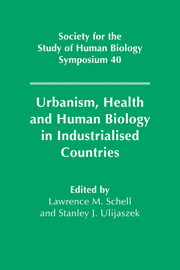Book contents
- Frontmatter
- Contents
- List of contributors
- Part I The urban environment
- Part II Epidemiology
- Part III Poverty and health
- Part IV Behavior and stress
- 12 Urbanism and psychosocial stress
- 13 Physical activity, lifestyle and health of urban populations
- 14 HIV transmission in urban environments: London and beyond
- Part V The future
- Index
14 - HIV transmission in urban environments: London and beyond
Published online by Cambridge University Press: 06 January 2010
- Frontmatter
- Contents
- List of contributors
- Part I The urban environment
- Part II Epidemiology
- Part III Poverty and health
- Part IV Behavior and stress
- 12 Urbanism and psychosocial stress
- 13 Physical activity, lifestyle and health of urban populations
- 14 HIV transmission in urban environments: London and beyond
- Part V The future
- Index
Summary
Editors' introduction
The transmission of the human immunodeficiency virus (HIV) and it's association with tuberculosis (TB) susceptibility has been highlighted by Di Ferdinando in chapter 5. In this chapter, Parker discusses another aspect of HIV transmission, that of sexual networks. Drawing upon fieldwork undertaken in London, Parker's observations show that sexual networks for potential HIV transmission in London cut across social class and across countries: while the majority of contacts were urban British, a significant number of urban United States (New York, San Francisco) and Australian (Sydney, Melbourne) individuals were also part of the network. The importance of the study of urban pathways discussed in the final chapter by Ulijaszek and Schell, and of global urban system given by Clark (chapter 3) is illustrated in this important case study.
Introduction
HIV infections, in common with other sexually transmitted infections, are not randomly distributed. In Europe and North America, for example, the majority of cases occur in large cities among men who have sex with other men. Recent figures published by the Public Health Laboratory Service for the United Kingdom illustrate this point: a total of 30,162 HIV cases were reported in September 1997 and 18,294 or 60.6% of these cases occurred among men who have sex with other men.
- Type
- Chapter
- Information
- Urbanism, Health and Human Biology in Industrialised Countries , pp. 280 - 308Publisher: Cambridge University PressPrint publication year: 1999
- 1
- Cited by



